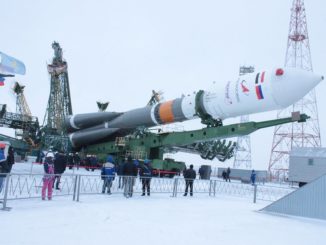
The second flight of China’s new medium-lift Long March 7A rocket successfully placed an experimental satellite into orbit Thursday, following a failed launch of the same configuration last year caused by a problem in a booster liquid oxygen system.
The Long March 7A rocket took off from the Wenchang launch base on Hainan Island in southern China at 12:51 p.m. EST (1751 GMT) Thursday, or 1:51 a.m. Beijing time Friday, according to China Aerospace Science and Technology Corp., or CASC, the largest state-owned contractor for the Chinese space program.
The deployed its payload into an elliptical, or oval-shaped, orbit ranging between 155 miles and 22,270 miles (250-by-35,840 kilometers), with an inclination of 19.5 degrees to the equator, according to independent tracking data released by the U.S. military.
China declared the mission a success. The state-run Xinhua news agency said the Shiyan 9 spacecraft launched by the Long March 7A rocket is designed “for in-orbit tests of new technologies including space environment monitoring.”
The Shiyan family of Chinese satellites are designed for technology demonstrations. Shiyan means “experiment” in Chinese.
Shiyan 9 is expected to use its own propulsion system to raise the perigee, or low point, of its orbit to geostationary altitude of more than 22,000 miles, or nearly 36,000 kilometers, over the equator. In that orbit, Shiyan 9 will circle Earth at the same rate of the planet’s rotation, giving the satellite a fixed position relative to the ground.
The launch Thursday marked the fourth flight of a Long March 7 rocket, and the second using the Long March 7A configuration.
The Long March 7 is designed to launch medium-sized satellites, such as Tianzhou resupply ships for China’s planned space station in low Earth orbit. The Long March 7A variant flies with a reignitable third stage, giving the rocket an ability to deploy satellites heading into higher orbits.
The Long March 7A rocket stands about 197 feet, or 60 meters, tall and can carry payloads of up to 15,400 pounds, or 7 metric tons, into geostationary transfer orbit. That is the same type of orbit the Long March 7A reached with the Shiyan 9 satellite Thursday.
China debuted the Long March 7A rocket in March 2020 after two successful flights of the basic Long March 7 configuration in 2016 and 2017. But the Long March 7A failed to reach orbit and fell back to Earth a few minutes after liftoff from Wenchang.
A report published by The Paper, a government-run digital newspaper based in Shanghai, said the Long March 7A launch failure last year was caused by low pressure in a liquid oxygen inlet feeding one of the rocket’s booster engines. Engineers traced the problem to “cavitation” in the liquid oxygen system feeding the booster, leading to pressures too low to allow the engine to continue firing, according to The Paper.
The Long March 7A is powered by four strap-on boosters powered by kerosene/oxygen-fed YF-100 engines, and a central core stage with two YF-100 engines. The rocket’s second stage has four YF-115 engines, also fed by kerosene and liquid oxygen, and two hydrogen-fueled YF-75 engines are on the new third stage added to create the Long March 7A configuration.
The failure last year occurred near the end of the burn by the four boosters and core stage engines, nearly three minutes into the mission.
The YF-100 engine is used on several of China’s new rockets. The strap-on boosters of China’s heavy-lift Long March 5 rocket are powered by YF-100 engines, and the same engine type flies on China’s light-class Long March 6 launcher and the Long March 8 rocket.
Before the Long March 7A’s second flight Thursday, China successfully launched three Long March 5 rockets, one Long March 6, and one Long March 8 mission last year.
China’s new Long March 5, 6, 7 and 8 rockets are designed to eventually replace the country’s older Long March vehicles, which use toxic propellants and launch from inland spaceports, often dropping spent stages near populated areas.
The Long March 7A rocket is a potential replacement for the Long March 3B for launches with geostationary satellites, offering a 25% improvement in payload capacity to geostationary transfer orbit.
According to CASC, the Long March 7A rocket will launch three to five times per year in the future, and engineers are developing a larger diameter payload fairing to accommodate larger satellites. Future upgrades to the Long March 7A will allow it to launch payloads directly into zero-degree inclination geostationary orbits, and deploy spacecraft heading to the moon and other planets, CASC said in a statement.
The next launch from Wenchang, where launching rockets drop boosters over the sea instead of land, is scheduled in late April with a Long March 5B rocket carrying the Tianhe core module for China’s space station.
Email the author.
Follow Stephen Clark on Twitter: @StephenClark1.



